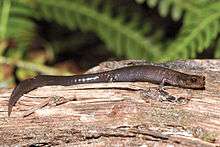Del Norte salamander
| Del Norte salamander | |
|---|---|
 | |
| Scientific classification | |
| Kingdom: | Animalia |
| Phylum: | Chordata |
| Class: | Amphibia |
| Order: | Urodela |
| Family: | Plethodontidae |
| Subfamily: | Plethodontinae |
| Genus: | Plethodon |
| Species: | P. elongatus |
| Binomial name | |
| Plethodon elongatus Van Denburgh, 1916 | |
The Del Norte salamander (Plethodon elongatus) is a species of salamander in the family Plethodontidae endemic to the United States in southwestern Oregon and northwestern California.[1][2][3]
Description
Plethodon elongatus is a medium-sized, slender salamander. Adults are 6–7.5 cm (2.4–3.0 in) from snout to vent, and 11–15 cm (4.3–5.9 in) in total length. Limbs are relatively short; toes are short and slightly webbed. Dorsal coloration is dark brown or black. A reddish or reddish-brown straight-edged mid-dorsal stripe may extend from the head to the tip of the tail; the stripe may be less pronounced in older animals.[3]
Life history
P. elongatus is a fully terrestrial salamander. Clutch size is three to 11 eggs (mean eight). No free-living larval stage exists, and juveniles hatch completely metamorphosed, measuring about 18 mm (0.71 in) in snout–vent length.[3]
Habitat and conservation
The species occurs in areas of moist talus and rocky substrates in redwood or Douglas fir forests. It is typically encountered among moss-covered rocks or under bark and other forest litter, usually avoiding very wet areas.[1]
The Del Norte salamander is locally abundant in suitable habitat. It is threatened by habitat loss caused by logging.[1]
References
- 1 2 3 4 Hammerson, G. & Welsh, H. (2004). "Plethodon elongatus". IUCN Red List of Threatened Species. Version 2015.3. International Union for Conservation of Nature. Retrieved 19 September 2015.
- ↑ Frost, Darrel R. (2015). "Plethodon elongatus Van Denburgh, 1916". Amphibian Species of the World: an Online Reference. Version 6.0. American Museum of Natural History. Retrieved 19 September 2015.
- 1 2 3 "Plethodon elongatus". AmphibiaWeb: Information on amphibian biology and conservation. [web application]. Berkeley, California: AmphibiaWeb. 2015. Retrieved 20 September 2015.
